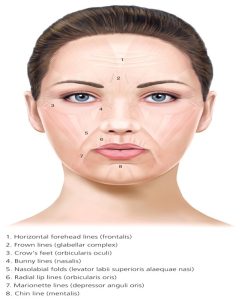Botox for Face Wrinkles
The first sign of aging are wrinkles around your eyes, nose, forehead, cheeks, and lips. Wrinkles are a normal feature of the human face but If your Crow’s feet around eyes, lines on your forehead, marionette lines and Jowls are making you appear aged than you actually are, then Botox is the treatment of choice . It will make you look younger and youthful and perfect.
Dynamic wrinkles best respond to Botox while static wrinkles can be handled by fillers.
What Is Botox?
Botox is a drug (botulinum toxin injections) which doctors have been using for many years to treat wrinkles and facial creases. Botox is a brand name of a toxin made by the bacterium Clostridium botulinum. Botox is the term you hear most often because it was the first injectable botulinum toxin.
Botulinum toxin was first approved by the U.S. Food and Drug Administration (FDA) for cosmetic use in 2002 as Botox to treat glabellar complex muscles that form frown lines and in 2013 to treat lateral orbicularis oculi muscles that form crow’s feet.
How Does Botox Work?
When botulinum toxin is injected, it blocks certain nerve signals that make muscles contract. The muscles relax, reducing unwanted wrinkles. This effect remains about 6-12 months. After that, the muscles move again and wrinkles come back.
What is the procedure and how long the effect last?
Your doctor uses a thin needle to inject few units of botulinum toxin into your skin or muscles. The number of injections needed depends on multiple factors, including the extent of the area being treated. This procedure takes only few minutes, and can be done right in the clinic on OPD basis. Within the first week of your treatment, you start noticing your muscles begin to relax and fewer facial lines and wrinkles. This effect wears off in about 6-12 months around. After that, the muscles move again and wrinkles returns again.
Who can get botulinum toxin injections?
- You need to be healthy and at least 18 years old before you can get botulinum toxin injections. If you are planning to get botulinum toxin injections, tell your doctor about your medical history and all the prescription medicines, vitamins, and herbal supplements you take.
- For reducing glabellar frown lines, crow’s feet at the side of the eyes, horizontal forehead creases, wrinkles around the mouth, nasolabial folds and smoothing out neck and chest/cleavage wrinkles
- to elevate the eyebrows
- to treat problems such as hyperhidrosis, lichen simplex, pompholyx (dyshidrotic eczema) and acne vulgaris
- Non cosmetic indications are conditions including blepharospasm, strabismus, cervical dystonia, migraines and muscle spasticity.
Who should not get Botox?
Some people should not get botulinum toxin. They include those who:
- have a neuromuscular disease
- are prgnant or nursing
- have weakness and numbness in certain facial muscles
- have dropping of eyelids , deep facial scars, or uneven facial features (when features are not the same on both sides of the face)
- have skin infection near the injection area
Side effects of Botox
- Headache
- Eye redness
- Redness or bruising in the injection area. This is more likely to happen if you take aspirin or blood-thinning medicine. Ask your doctor if you should stop taking those medicines a few days before getting a botulinum toxin injection.
- Rare, but sometimes ptosis or drooping of eyelids

